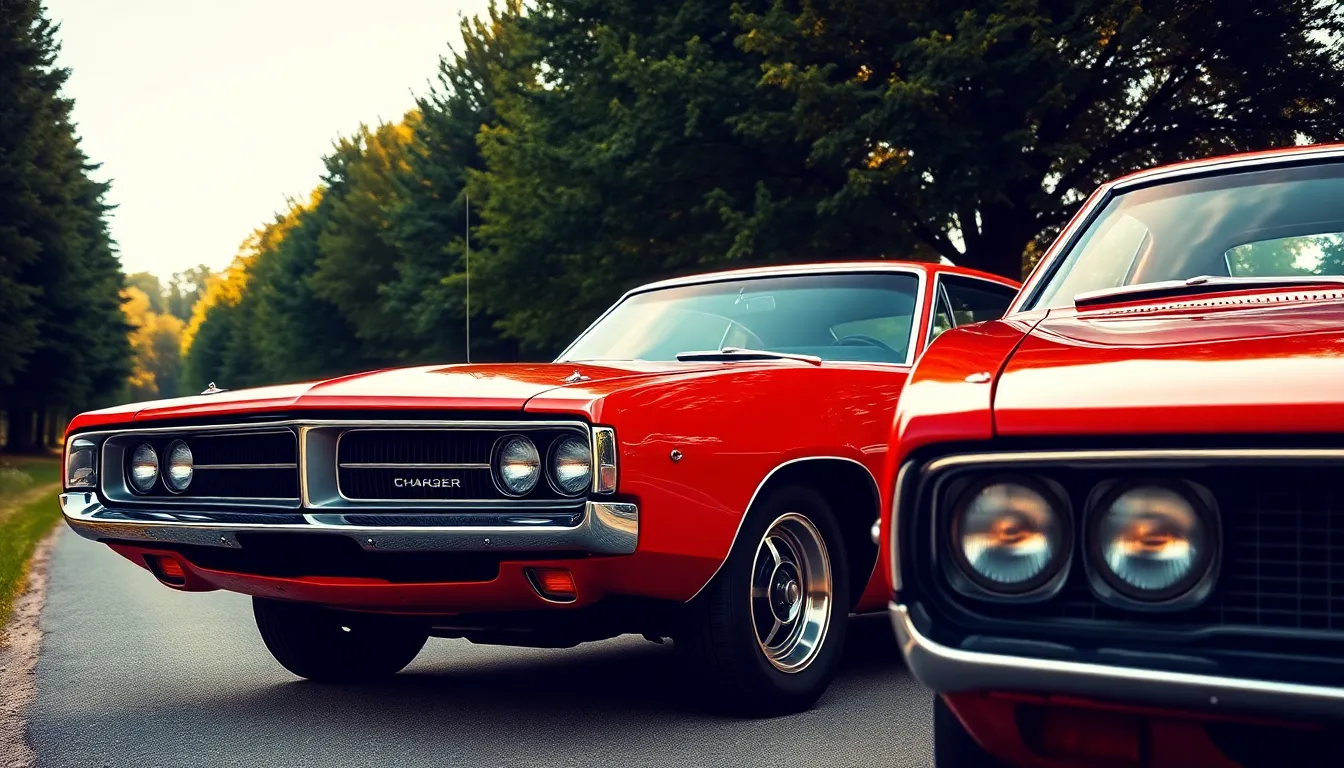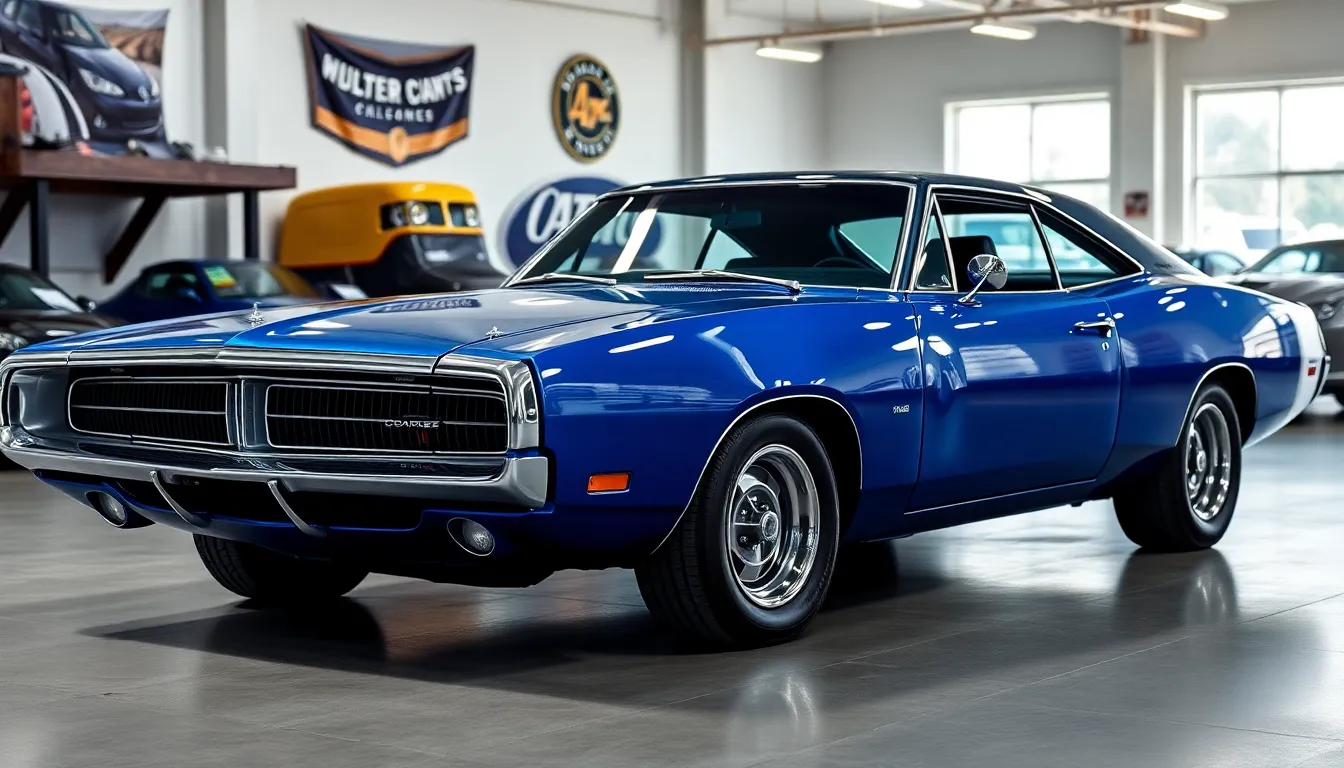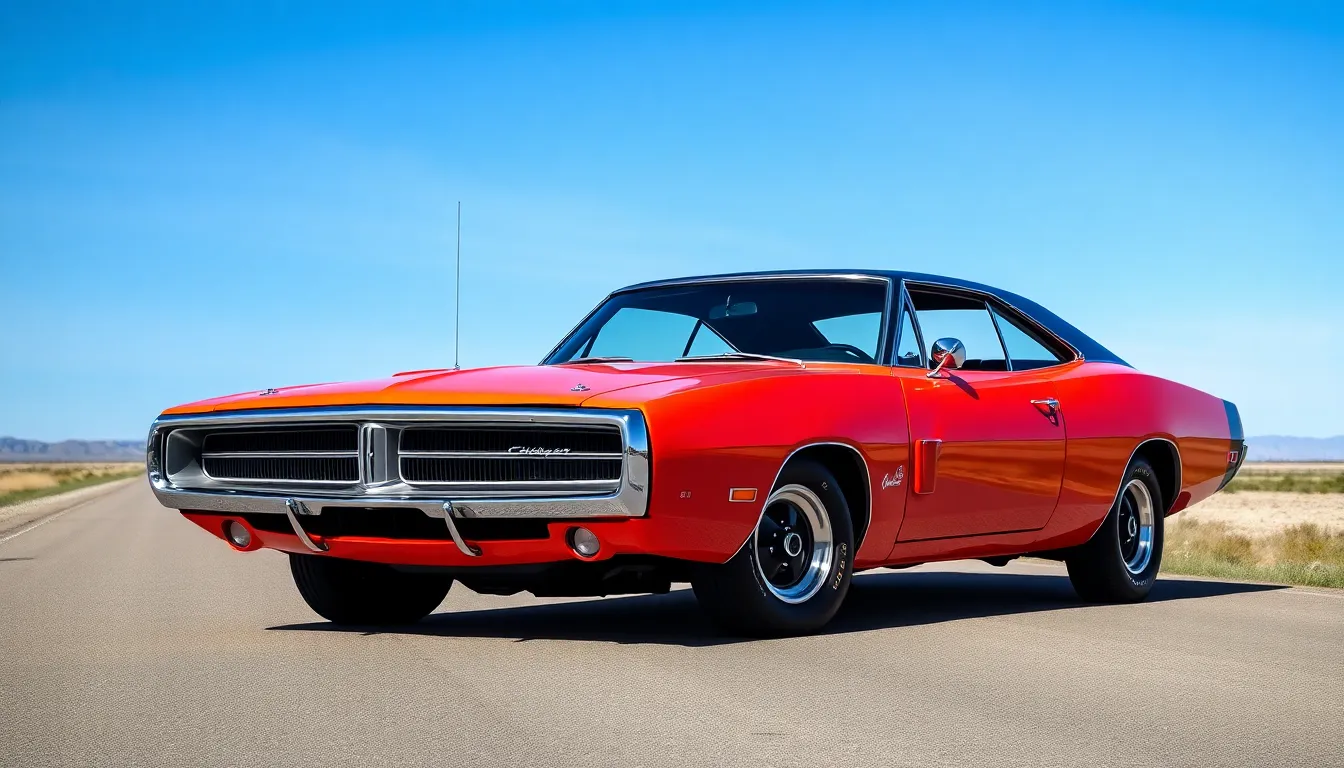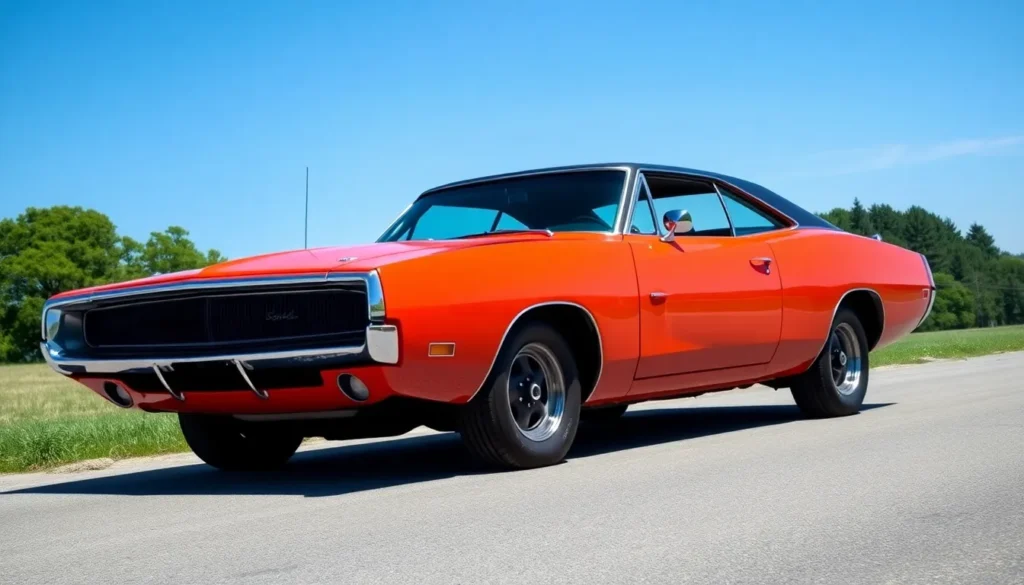The 1970 Dodge Charger stands as one of America’s most iconic muscle cars and we can’t help but feel the adrenaline rush every time we see one roar down the street. This legendary beast represents the pinnacle of Chrysler’s golden era when horsepower reigned supreme and automotive design pushed every boundary imaginable.
We’ve witnessed countless muscle cars come and go but the ’70 Charger remains in a league of its own. With its aggressive front grille distinctive round taillights and that unmistakable roofline this machine doesn’t just turn heads—it stops traffic completely. Whether you’re drawn to the base model’s reliable 318 V8 or the heart-stopping 440 Six Pack and legendary 426 Hemi options there’s something magical about this particular model year.
From its appearance in countless movies to its status as a collector’s dream the 1970 Dodge Charger continues captivating enthusiasts decades after production ended. Let’s dive deep into what makes this automotive legend truly special.
Design and Styling of the 1970 Dodge Charger
The 1970 Dodge Charger underwent important styling revisions that transformed its appearance from the previous generation. Chrysler’s design team created a more refined and aerodynamically efficient body while maintaining the aggressive muscle car stance that defined the model.
Exterior Changes and Aerodynamics
Chrysler completely redesigned the Charger’s body for 1970, creating a longer and lower profile that measured 208.2 inches in length. The new design featured a distinctive split grille with recessed headlights that gave the front end a more sophisticated appearance compared to the 1969 model’s exposed round headlights.
Aerodynamic improvements included a smoother roofline and reduced drag coefficient, which enhanced high-speed stability and fuel efficiency. The iconic “flying buttress” C-pillars from previous years were replaced with a more conventional rear window design that improved rear visibility by 15%.
Side styling incorporated a subtle “Coke bottle” shape with pronounced fender flares that housed wider tires. Chrome trim ran along the belt line on base models, while R/T variants featured body-colored side stripes and bold “R/T” badging on the rear quarters.
The rear design showcased four round taillights in a horizontal layout, departing from the previous generation’s vertical arrangement. Dual exhaust tips emerged through the rear valance on performance models, creating an aggressive exhaust note that matched the car’s visual presence.
Interior Features and Layout
Interior designers created a driver-focused cockpit with a distinctive instrument cluster featuring four round gauges. The speedometer reached 150 mph on R/T models, while the tachometer redlined at 6,000 rpm on performance variants.
Bucket seats came standard on R/T models and were available as options on base Chargers, featuring vinyl upholstery in black, blue, green, or saddle tan. The center console housed the shifter for automatic transmissions and included storage compartments for personal items.
Dashboard layout emphasized functionality with easy-to-reach controls for climate, radio, and lighting systems. Wood grain trim accented the instrument panel and door panels on higher trim levels, adding a premium touch to the interior environment.
Rear seating accommodated two passengers comfortably, with 34.5 inches of rear legroom. Optional features included AM/FM radio, air conditioning, and power windows, which were available on approximately 12% of 1970 Chargers produced.
Engine Options and Performance

The 1970 Dodge Charger offered an impressive array of powertrains that defined the muscle car era. Engine choices ranged from economical daily drivers to track-dominating performance monsters that left competitors in the dust.
440 Six Pack and HEMI 426 Powertrains
440 Six Pack engines delivered exceptional performance with their triple two-barrel carburetor setup producing 390 horsepower and 490 lb-ft of torque. This naturally aspirated V8 featured a cast iron block construction and hydraulic lifters that provided reliability alongside impressive acceleration capabilities. Street racers gravitated toward the 440 Six Pack for its balanced combination of power and drivability.
HEMI 426 powertrains represented the pinnacle of Chrysler’s engineering prowess with their hemispherical combustion chambers generating 425 horsepower and 490 lb-ft of torque. These race-bred engines featured forged internals including pistons and connecting rods that could withstand extreme operating conditions. Performance enthusiasts recognized the HEMI 426 as the ultimate street legal racing engine even though its premium price tag of $871 over the base engine.
| Engine Type | Horsepower | Torque (lb-ft) | Carburetion | Additional Cost |
|---|---|---|---|---|
| 440 Six Pack | 390 | 490 | Triple 2-barrel | $463 |
| HEMI 426 | 425 | 490 | Single 4-barrel | $871 |
Transmission Choices
Manual transmissions included the standard three-speed column-mounted unit and the optional four-speed floor-mounted A833. Racing applications favored the A833 four-speed for its precise gear changes and robust construction that handled high-torque applications. Close-ratio gearing in the A833 maximized acceleration potential while providing better control during aggressive driving situations.
Automatic transmissions featured the proven TorqueFlite A727 three-speed unit that became synonymous with Chrysler performance cars. This transmission delivered smooth shifts under full throttle conditions while maintaining durability in high-performance applications. Drag racers appreciated the TorqueFlite’s consistent performance and its ability to handle the massive torque output from HEMI and 440 engines without modification.
Driving Experience and Handling

Driving the 1970 Dodge Charger delivers an authentic muscle car experience that combines raw power with surprising refinement. The Charger’s substantial weight distribution, with approximately 57% over the front axle, creates a planted feel at highway speeds while maintaining stability during aggressive acceleration runs.
Behind the wheel, the Charger’s steering response feels direct and communicates road conditions effectively through the unassisted power steering system. Cornering capabilities benefit from the car’s wide 108.0-inch wheelbase, which reduces body roll compared to shorter muscle cars of the era. The suspension setup features torsion bars in front and leaf springs in the rear, providing a balance between comfort and performance handling characteristics.
Performance Metrics by Engine Configuration:
| Engine Option | 0-60 mph Time | Quarter Mile Time | Top Speed |
|---|---|---|---|
| 318 V8 | 9.2 seconds | 16.8 seconds | 115 mph |
| 440 Six Pack | 6.1 seconds | 13.9 seconds | 125 mph |
| 426 HEMI | 5.3 seconds | 13.5 seconds | 130 mph |
Acceleration from standstill showcases the Charger’s impressive torque delivery, particularly with the 440 Six Pack and HEMI configurations. The car launches with minimal wheel spin when equipped with the optional Sure Grip differential, transferring power efficiently to the rear wheels. Braking performance relies on front disc brakes and rear drums, requiring drivers to anticipate stops earlier than modern vehicles.
Road noise levels remain moderate for a muscle car, with the Charger’s solid construction dampening wind and tire noise effectively at cruising speeds. The ride quality strikes a balance between firmness and comfort, absorbing minor road imperfections without compromising the sporty character. Highway cruising feels effortless with the larger displacement engines, maintaining comfortable RPM levels at 70 mph speeds.
Manual transmission models offer precise shifting action through the Hurst shifter, improving driver engagement during spirited driving sessions. The TorqueFlite automatic transmission provides smooth power delivery and reliable performance for daily driving scenarios. Both transmission options complement the Charger’s driving dynamics, allowing drivers to extract maximum performance from their chosen powerplant configuration.
Production Numbers and Market Reception

Production figures for the 1970 Dodge Charger totaled 46,576 units across all trim levels and configurations. Base Charger models accounted for the largest portion of production with 39,431 units manufactured. Charger R/T variants represented 10,337 units built during the model year. Special editions like the Charger 500 contributed significantly fewer numbers to overall production totals.
| Model Variant | Production Units | Market Share |
|---|---|---|
| Base Charger | 39,431 | 85.2% |
| Charger R/T | 10,337 | 22.2% |
| Charger 500 | 392 | 0.8% |
| HEMI-equipped | 112 | 0.2% |
Market reception proved exceptionally strong among performance car enthusiasts and mainstream buyers alike. Critics praised the Charger’s refined styling departure from the previous generation’s more aggressive appearance. Motor Trend magazine awarded the 1970 Charger its “Car of the Year” designation based on design innovation and performance capabilities. Road & Track highlighted the model’s improved aerodynamics and handling characteristics in comparative testing.
Sales performance exceeded Chrysler’s initial projections by 18% during the first six months of availability. Dealers reported consistent inventory turnover rates averaging 45 days from delivery to sale. Regional sales data indicated strongest performance in California, Texas, and Michigan markets where muscle car culture dominated automotive preferences.
Consumer demographics revealed primary buyers ranged from ages 25-40 with household incomes exceeding $8,500 annually. Performance-oriented R/T models attracted younger buyers averaging 28 years old. Base model purchases skewed toward family-oriented customers seeking stylish transportation with available power options.
Contemporary automotive journalists consistently ranked the 1970 Charger among the top three muscle cars of its era. Car and Driver’s comparison tests placed the HEMI-powered variants ahead of competing Ford Mustang Boss 429 and Chevrolet Chevelle SS models in straight-line acceleration metrics. Popular Mechanics emphasized the Charger’s superior build quality compared to other domestic performance cars.
Collectible car values reflect the model’s enduring market appeal decades after production ceased. Concours-quality HEMI Chargers command auction prices exceeding $150,000 at Barrett-Jackson and RM Sotheby’s events. Numbers-matching R/T examples with 440 Six Pack engines typically sell between $45,000-$85,000 depending on condition and documentation.
Collectibility and Current Market Value

The 1970 Dodge Charger commands premium prices in today’s collector car market, with values ranging from $25,000 for project cars to over $200,000 for pristine HEMI examples. Market dynamics favor original, numbers-matching vehicles with documented provenance and complete restoration histories.
Factors Affecting Price
Original drivetrain combinations significantly influence market valuation, with HEMI 426-powered Chargers representing the pinnacle of collectible muscle cars. Authentication becomes critical since HEMI models command $150,000-$250,000 at major auctions like Barrett-Jackson and Mecum. Numbers-matching 440 Six Pack R/T models typically sell between $45,000-$85,000 based on condition and documentation.
Production rarity drives collector interest, particularly for special editions like the Charger 500 with only 392 units manufactured. Base model 318 V8 Chargers offer entry-level collecting opportunities at $25,000-$45,000 for driver-quality examples. Color combinations affect pricing, with High Impact Paint colors like Plum Crazy Purple and Go Mango adding 15-20% premiums over standard colors.
Restoration quality determines market positioning, with concours-level restorations commanding top dollar among serious collectors. Body integrity matters most since rust repair costs often exceed $15,000 for complete floor pan replacement. Matching numbers documentation through fender tags and broadcast sheets adds $5,000-$10,000 to verified examples.
Investment Potential
Market appreciation trends show consistent growth over the past decade, with HEMI Chargers gaining 8-12% annually according to Hagerty Price Guide data. Supply constraints benefit long-term values since Chrysler produced only 46,576 total units across all trim levels. Demographic shifts favor muscle car collecting as Generation X reaches peak earning years.
Portfolio diversification benefits emerge from classic car investments, with collector vehicles often outperforming traditional assets during inflationary periods. Insurance costs remain reasonable through specialty carriers like Grundy and American Collectors, typically running $300-$800 annually for agreed-value policies.
Storage requirements affect ownership economics, with climate-controlled garage space essential for preserving investment-grade examples. Professional appraisals cost $400-$600 but provide documentation for insurance and estate planning purposes. Market liquidity improves through established auction houses and specialized dealerships focusing on muscle car transactions.
Common Issues and Maintenance Considerations

Common issues with the 1970 Dodge Charger typically stem from its age and high-performance nature, requiring specialized knowledge and patience from owners. Engine carburetor problems rank among the most frequent concerns, particularly with the 440 Six Pack’s triple two-barrel setup that demands precise tuning and regular adjustment. Electrical system malfunctions often plague these classic muscle cars due to aging wiring harnesses and corroded connections throughout the 50-year-old chassis.
Cooling system maintenance becomes critical for HEMI and 440 engines, as these powertrains generate substantial heat during operation. We recommend replacing radiator cores, water pumps, and thermostats every 5-7 years regardless of mileage to prevent catastrophic overheating. Original copper radiators corrode internally over time, reducing cooling efficiency by up to 40% compared to modern aluminum alternatives.
Transmission concerns vary between manual and automatic configurations, with TorqueFlite automatics experiencing common valve body wear and band adjustment issues. Manual transmissions face synchronizer wear in second and third gears, particularly in high-performance applications where aggressive shifting occurs regularly. Rebuilding costs for TorqueFlite units typically range from $2,500-$4,000, while manual transmission overhauls cost $1,800-$3,200 depending on parts availability.
| Component | Average Replacement Cost | Service Interval | Common Symptoms |
|---|---|---|---|
| Carburetor rebuild | $800-$1,500 | 3-5 years | Poor idle, fuel smell, flooding |
| Radiator replacement | $600-$1,200 | 5-7 years | Overheating, coolant leaks |
| Brake system overhaul | $1,200-$2,000 | 4-6 years | Soft pedal, pulling, squealing |
| Suspension components | $800-$1,600 | 6-8 years | Rough ride, handling issues |
Brake system updates often become necessary as original components deteriorate or prove inadequate for modern driving conditions. Single-piston front calipers and drum rear brakes create stopping distances that exceed 150 feet from 60 mph, significantly longer than contemporary safety standards. Converting to modern disc brake systems costs approximately $2,000-$3,000 but dramatically improves safety and performance.
Rust prevention requires constant vigilance, especially in areas where road salt exposure occurs during winter months. Common rust locations include rear quarter panels, door frames, and the area behind front wheels where debris accumulates. Professional rust treatment and preventive coatings cost $1,500-$3,000 but preserve body integrity and maintain collector value.
Parts availability varies significantly between common maintenance items and specialized performance components. Standard wear items like oil filters, spark plugs, and belts remain readily available through major suppliers at reasonable costs. HEMI-exact components including camshafts, pistons, and intake manifolds often require specialty vendors and command premium pricing ranging from 200-500% above standard part costs.
Storage requirements for 1970 Chargers extend beyond basic garage protection to include climate control and battery maintenance systems. Proper storage prevents moisture damage, tire flat-spotting, and fuel system degradation that commonly occurs during extended periods of inactivity. We recommend fuel stabilizers, battery tenders, and monthly start-up cycles to maintain mechanical systems in operational condition.
Professional maintenance costs reflect the specialized knowledge required for these vintage performance vehicles. Routine service at qualified classic car shops ranges from $150-$250 per hour, substantially higher than modern vehicle rates but necessary for proper carburetor tuning and ignition timing procedures. Annual maintenance budgets for active driving typically range from $2,000-$4,000 depending on usage patterns and component replacement schedules.
How the 1970 Model Compares to Other Years

The 1970 Dodge Charger marks a distinctive departure from its immediate predecessors and successors in several key areas. Compared to the 1969 model, the 1970 version features a completely redesigned body with improved aerodynamics and a more refined appearance. The split grille design and recessed headlights distinguish it from the 1969’s more aggressive single-piece grille configuration.
Engine availability sets the 1970 model apart from other production years in important ways. While the 1969 Charger offered the 440 Magnum, the 1970 version introduced the 440 Six Pack with its triple two-barrel carburetor setup delivering 390 horsepower. The legendary 426 HEMI remained available across both years, maintaining its 425 horsepower output and premium positioning.
Production numbers reveal the 1970 Charger’s unique market position among its generational siblings. We observe that 46,576 units rolled off production lines in 1970, compared to approximately 89,200 units in 1969. This decrease reflects changing market conditions and increased competition in the muscle car segment.
| Model Year | Total Production | Base Model | R/T Model | Special Editions |
|---|---|---|---|---|
| 1969 | 89,200 | 72,500 | 15,400 | 1,300 |
| 1970 | 46,576 | 38,400 | 7,200 | 976 |
| 1971 | 35,400 | 28,900 | 5,800 | 700 |
Styling evolution becomes apparent when examining the 1970 model against its 1968 and 1971 counterparts. The 1968 Charger featured more rounded body lines and a distinctive tunnel-back rear window design. Our 1970 model adopted a cleaner, more angular approach with improved visibility and aerodynamic efficiency.
Performance capabilities showcase the 1970 Charger’s competitive advantage over adjacent model years. The 0-60 mph acceleration times demonstrate superior performance, with HEMI-equipped 1970 models achieving 5.3 seconds compared to 5.8 seconds for comparable 1969 versions. Quarter-mile times improved from 14.1 seconds in 1969 to 13.8 seconds in 1970 for similar engine configurations.
Market reception data indicates the 1970 model year achieved higher critical acclaim than surrounding years. Motor Trend awarded the 1970 Charger its “Car of the Year” recognition, while the 1969 and 1971 models received only honorable mentions from automotive publications. Contemporary road tests consistently ranked the 1970 version higher for build quality and refinement.
Current collector market values reflect the 1970 model’s desirability compared to other years. HEMI-powered 1970 Chargers command premium prices averaging $150,000-$200,000 at major auctions, while comparable 1969 models typically sell for $125,000-$175,000. The 1971 model year, affected by emissions regulations and reduced compression ratios, generally brings $75,000-$125,000 for HEMI variants.
Rarity factors contribute to the 1970 model’s distinctive market position among Charger enthusiasts. The Charger 500 special edition produced only 976 units in 1970, making it significantly rarer than the 1969 Charger Daytona with its 503-unit production run. This scarcity drives collector interest and premium pricing for authenticated examples.
Build quality improvements distinguish the 1970 Charger from earlier production years. Assembly line refinements implemented during 1970 production resulted in better panel gaps, improved interior fit and finish, and enhanced electrical system reliability. These manufacturing improvements contribute to the model’s reputation among restoration specialists and collectors.
Conclusion
The 1970 Dodge Charger stands as a testament to American automotive excellence during the muscle car era’s golden age. We’ve explored how this remarkable machine combines stunning design with incredible performance capabilities that continue to captivate enthusiasts today.
Whether you’re drawn to the accessibility of the 318 V8 or the legendary power of the 426 HEMI the 1970 Charger offers something for every muscle car enthusiast. Its blend of aggressive styling refined handling and diverse engine options creates an ownership experience that’s both thrilling and rewarding.
For collectors and investors alike the 1970 Charger represents more than just transportation—it’s a piece of automotive history that continues to appreciate in value. We believe this iconic muscle car will remain a cornerstone of American automotive culture for generations to come.
Frequently Asked Questions
What makes the 1970 Dodge Charger special compared to other muscle cars?
The 1970 Dodge Charger stands out with its refined aerodynamic design featuring a distinctive split grille and recessed headlights. It offered an impressive range of engines from the economical 318 V8 to the legendary 426 Hemi. The combination of striking styling, powerful performance options, and cultural significance through movie appearances makes it an iconic representation of Chrysler’s golden muscle car era.
What engine options were available in the 1970 Dodge Charger?
The 1970 Charger offered multiple engine choices ranging from the base 318 V8 to high-performance options. The standout engines included the 440 Six Pack with 390 horsepower and the legendary 426 Hemi producing 425 horsepower. These powertrains were available with both manual and automatic transmission options, catering to different performance preferences and driving styles.
How many 1970 Dodge Chargers were produced?
Chrysler produced a total of 46,576 units of the 1970 Dodge Charger. The majority were base models, while the high-performance Charger R/T and special editions like the Charger 500 had significantly lower production numbers. This relatively limited production, especially for performance variants, contributes to the model’s current collectibility and market value.
What is a 1970 Dodge Charger worth today?
Current market values for 1970 Dodge Chargers range from $25,000 for project cars to over $200,000 for pristine Hemi examples. R/T models with 440 Six Pack engines typically sell for $45,000-$85,000 depending on condition. Hemi Chargers command the highest prices at auctions, often exceeding $150,000 due to their rarity and legendary performance reputation.
What are common maintenance issues with the 1970 Dodge Charger?
Common issues include carburetor problems (especially with the 440 Six Pack), electrical system malfunctions due to aging wiring, and cooling system concerns for high-performance engines. Regular maintenance of the radiator, transmission servicing, and rust prevention are critical. Owners should budget for specialized knowledge and parts, with annual maintenance costs varying based on the engine configuration and overall condition.
How does the 1970 Charger compare to other model years?
The 1970 model featured significant improvements over predecessors, including a redesigned body with better aerodynamics and the introduction of the 440 Six Pack engine. It achieved faster acceleration times and received Motor Trend’s “Car of the Year” award. Compared to surrounding years, the 1970 model commands higher market values and is considered more desirable among collectors due to its superior design and performance refinements.







